North America Alcoholic Drinks Packaging Market Size
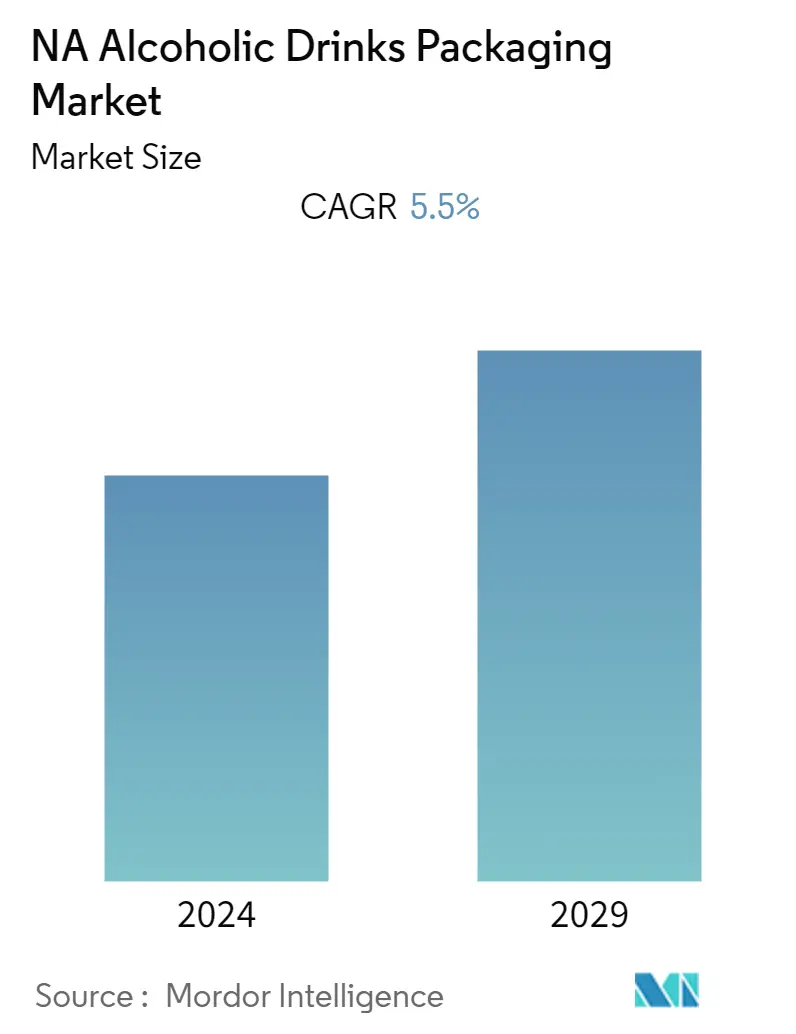
| Study Period | 2019 - 2029 |
| Base Year For Estimation | 2023 |
| Forecast Data Period | 2024 - 2029 |
| Historical Data Period | 2019 - 2022 |
| CAGR | 5.50 % |
| Market Concentration | Medium |
Major Players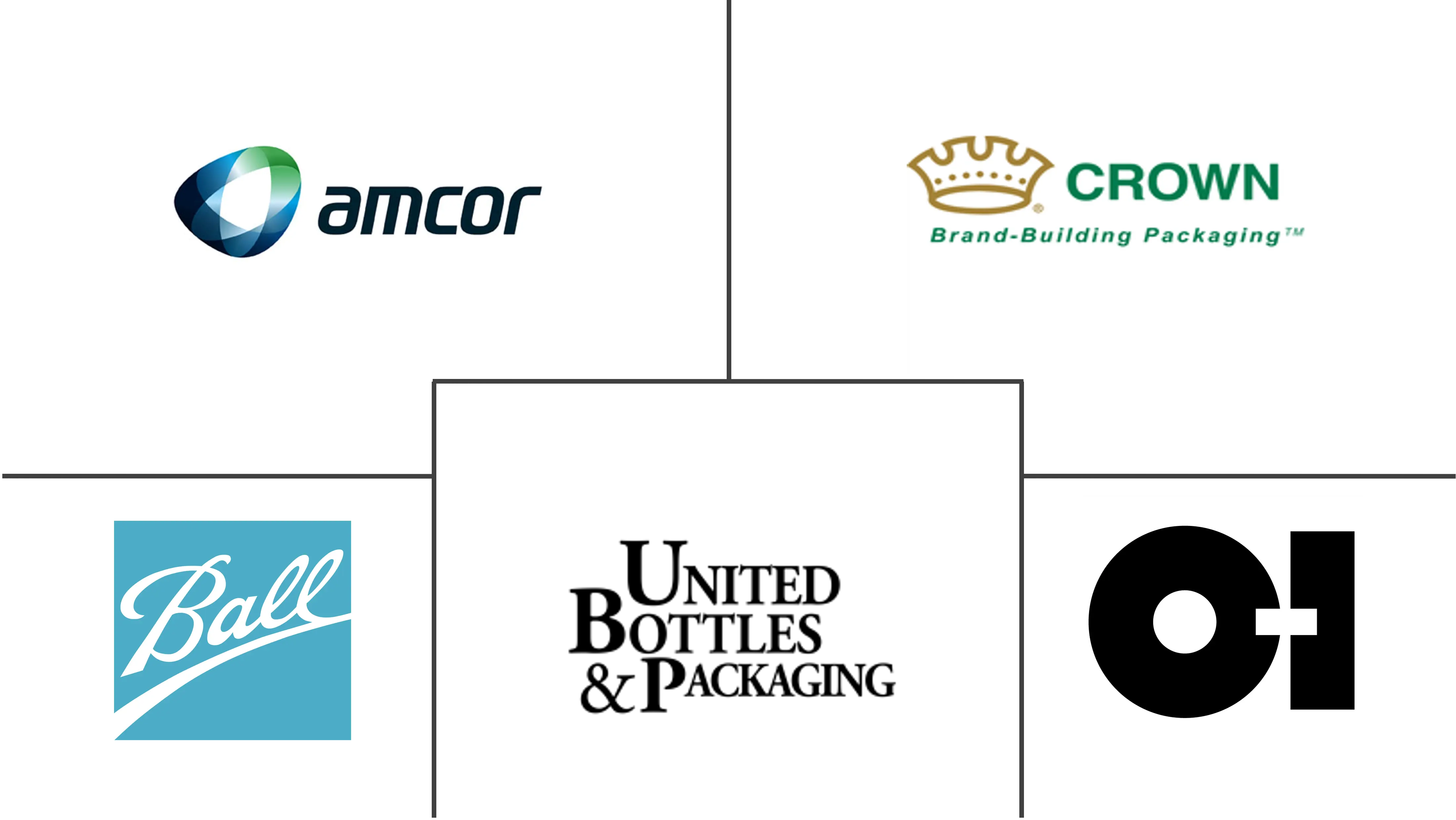
*Disclaimer: Major Players sorted in no particular order |
North America Alcoholic Drinks Packaging Market Analysis
The North America Alcoholic Drinks Packaging Market is expected to grow at a CAGR of 5.5% during the forecast period (2021-2026). The packaging of alcoholic beverages plays a significant role in the brand promotion of alcohol. The alcoholic beverage industry highlights the innovations, including enhanced branding and unconventional packaging formats, such as paper wine bottles, whiskey pouches, etc.
- According to Krones AG, alcoholic beverage consumption reached 244 billion liters in 2020, making it the second most consumed packed beverage type in the world. The United States alcoholic beverage market is expected to be the largest alcohol market worldwide, with a projected market value of about 387.6 billion USD by 2027, according to Jefferies Group LLC. Canada ranked 10th with a market value projected at around USD 48.17 billion, amounting to one-eight of the United States alcohol market.
- Due to COVID-19, overall consumption of alcoholic beverages didn't change much: beer and wine sales rose, whereas hard liquor sales declined. Demand for budget and mid-priced spirits increased, while demand for high-end super-premium and ultra-premium spirits decreased. As consumers limit interactions and spend more time at home, there have been huge spikes in demand for wholesale wine and beer. Consumers are also spending more per bottle than before the pandemic.
- Changes in shopping and drinking patterns during the pandemic have led to a shift towards large packaging formats, such as bag-in-a-box, and small packaging formats, such as cans. Bag-in-box wine sales are booming along with canned wine in the United States. While the expansion of the bag-in-box format is largely seen as a temporary trend driven by lockdown shopping habits and consumers' desire to stock up, but canned wine has long-term appeal.
- Manufacturers of canned wine and beer witnessed a huge demand for aluminum can packaging, and this is due to new formats such as cans gaining wider acceptance in recent years. This trend has been increasingly driven by a significant cultural shift, as consumers, with millennials particularly standing out as keen adopters of different wine formats that offer convenience.
- A prominent whisky brand Johnnie Walker announced that it would release a limited edition of Johnnie Walker whisky using bottles made of paper rather than glass. To create the bottle, Diageo, the parent company of Johnnie Walker, partnered with venture management company Pilot Lite to launch Pulpex Limited, a new sustainable packaging technology company. According to Diageo, it is the world's first plastic-free paper-based spirit bottle. The paper will be supplied from sustainably-sourced wood pulp, and the whisky will be launched by the end of 2021. This must be seen as a significant effort made by any alcohol brand towards sustainable packaging.
North America Alcoholic Drinks Packaging Market Trends
This section covers the major market trends shaping the North America Alcoholic Drinks Packaging Market according to our research experts:
Wine Consumption is expected to Grow Significantly
- Covid-19 has spurred an exponential increase in alcohol e-commerce and digital engagement. Since e-commerce allows consumers to compare, review, and discover between different alcoholic beverages. It is particularly well suited to the wine segment since people get a fair idea about the taste and smell of wine even before taking a single sip.
- According to the State of the US Wine Industry 2021 Report by Silicon Valley Bank, the domestic and imported US wine market volume increased by 1.45% and 14.33%, respectively. Millennials are adopting wine at a faster rate than any other generation. They are estimated to have low brand loyalty. In general, they like to experiment with distinct-tasting wines from various regions in different packaging, which greatly appeals to their sense of adventure.
- Consumers are receiving PET wine bottles positively, as the bottles are unbreakable and easier to carry, making them exceptional for cottages, parties, and outdoor events. Moreover, consumers appreciate the environmental benefits, which are further favoring innovations in the packaging.
- For wine, packaging and branding is an important aspect, which is evolving, and many suppliers are extending and launching their current/new brands in this space. For instance, United States-based wine producer EandJ Gallo launched a new brand, “Naked Grape,” in the 3-liter box category of wine and got successful. Other brands are also experimenting with innovative packaging solutions to stand out on the store shelf. For instance, the Sofia brand sells wine in pink cans, and the Bandit brand packages its wine in small, sustainable 500 ml and one-liter cartons.
- According to the United Nations of Fine Wines, Veganism is one of the fastest-growing wine trends. It is also reflected in wine production, leading to more vegan-friendly wines, which would require the glass bottles because of zero rates of chemical reactions ensuring that the wine inside the glass bottle has its aroma and flavor intact. This new trend will help the glass packaging segment to retain its top position in the given market.
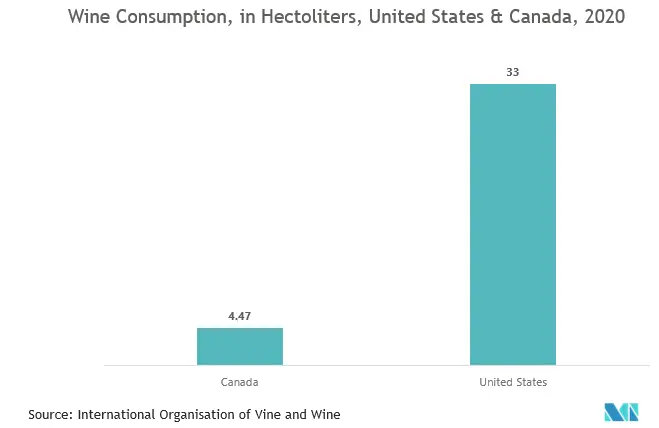
United States is Expected to Hold Significant Market Share
- The United States consumes the largest volume of wine of any country, at 33 million hectoliters in 2020, which is more than seven times Canada's total wine consumption. Portability and convenience became significant drivers in wine packaging innovation, which led to United States-based new-age wine sellers Bota Box and Black Box to explore alternative packagings, such as tetra packs and bag-in-box wine and cartons. According to the State Of Wine Industry Report 2020 by Silicon Valley Bank, canned wine in the country has recorded an 80% growth in 2019, despite the 0.5% as an overall share.
- Lightweight glass has been the major innovation in recent times, offering the same resistance as the older glass materials and higher stability while reducing the volume of the raw materials used. Also, alcoholic drinks are expected to lead the way for the glass packaging market, owing to the decent sales of beer and whiskey in the United States, with an increasing demand for premium variants.
- In 2020, the United States witnessed the biggest volume gain in total beverage alcohol volume in nearly twenty years. It was up by 2%, the most significant increase since 2002. Among alcoholic beverages, beer witnessed substantial growth in the past few years. The majority of beer volume is sold in glass bottles and is driving the need for increased production rates in the glass packaging industry. The increasing demand for premium variants in alcoholic drinks like whiskey, rum, etc., is also driving the growth of glass bottles.
- However, the ongoing trade war between the United States and China may impact the glass packaging market in the country. Ardagh Group stated that over 70% of the US wine industry glass bottles are imported from China; and due to increase in the tariff rate imposed on China imports, the need for improving glass manufacturing infrastructure is expected to rise, leading to an increase in the overall cost of the product in coming years.
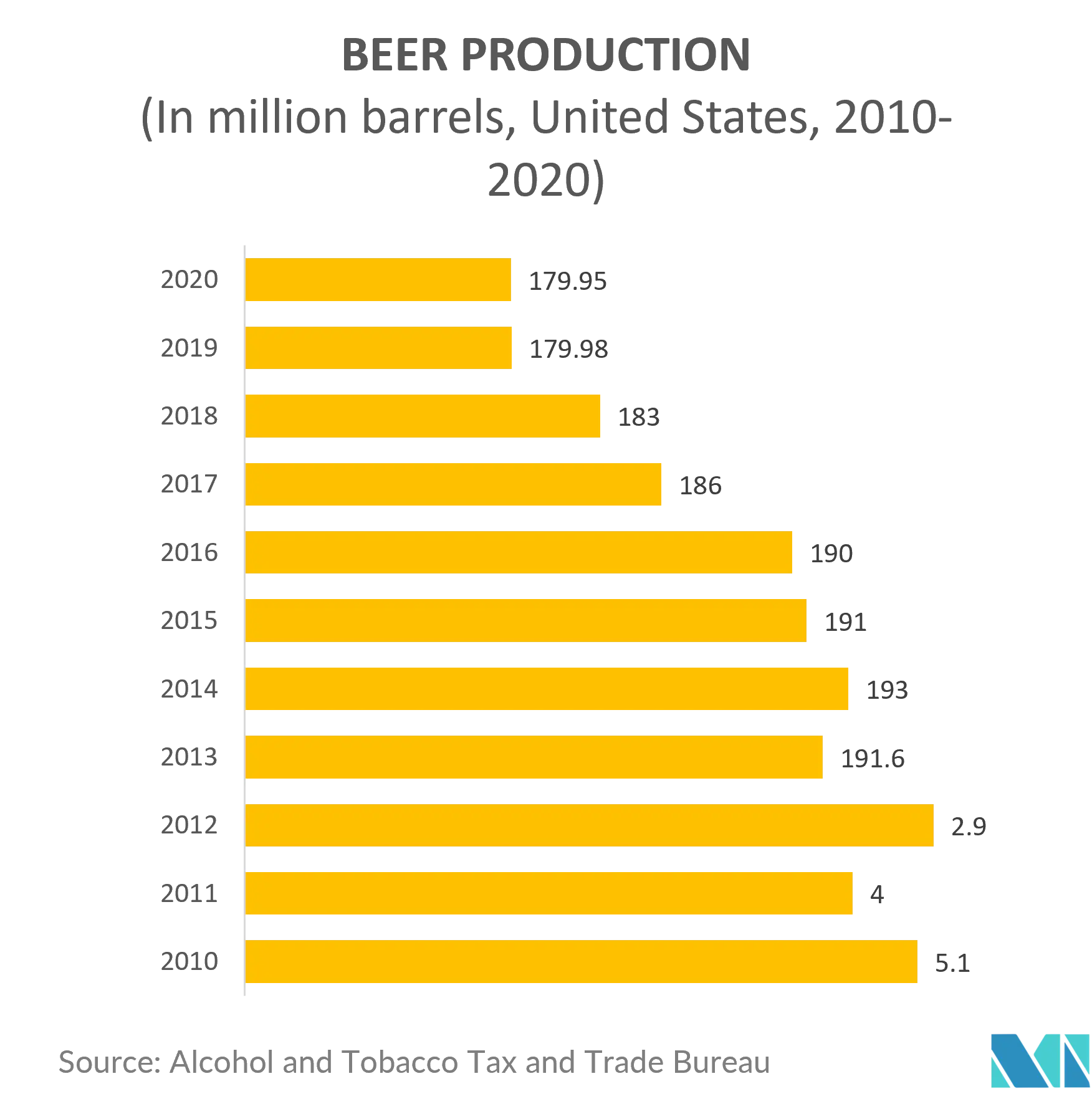
North America Alcoholic Drinks Packaging Industry Overview
The availability of several players providing packaging solutions for alcoholic beverages has intensified the competition in the market. Therefore, the market is moderately fragmented, with many companies developing expansion strategies. Some of the recent developments are:
- February 2020 - Garçon Wines collaborated with Amcor plc to produce flat wine bottles made with post-consumer recycled (PCR) PET plastic in the United States. Amcor's PET Bottles are sleek, modern, and perfectly match with today's lifestyle requirements for convenience and sustainability. PET bottles are unbreakable, beach- and pool-friendly, and also have environmental benefits since they are lightweight, infinitely recyclable, and have a lower carbon footprint than glass bottles or aluminum cans.
- July 2020, The Can pack Group and Giorgi Global Holdings, Inc., situated in Blandon, Pennsylvania, and the owner of the Canpack Group jointly announcedCanpack'ss acquisition of industrial property in Olyphant, Pennsylvania. This is in line with a goal to expand manufacturing facilities in North America.
North America Alcoholic Drinks Packaging Market Leaders
-
Ball Corporation
-
Crown Holdings Inc.
-
United Bottles & Packaging
-
Owens-Illinois Inc.
-
Amcor plc
*Disclaimer: Major Players sorted in no particular order
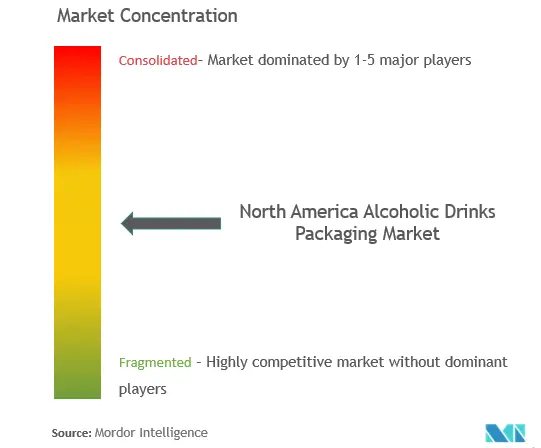
North America Alcoholic Drinks Packaging Market News
- March 2021 - Owens-Illinois (O-I), Inc., made a significant investment to support strong customer demand for highly sustainable glass packaging. O-I will invest approximately USD 75 million in an expansion at its Zipaquirá, Colombia facility. Upon completion by the end of 2022, the project is expected to add nearly 2% capacity to the company's Americas segment and produce about 500 million bottles annually.
- June 2021- AB InBev developed the lightest longneck beer bottle for commercial production. The brewer and owner of brands such as Budweiser, Stella Artois, Corona, Beck's, and Leffe reduced the weight of its standard longneck beer bottle from around 180 to 150 grams, cutting its CO2 emissions by 17% per bottle. Developed at the brewer's Global Innovation and Technology R&D Centre, GITEC, in Leuven, Belgium, the technique combines different technologies to deliver a more sustainable bottle while still maintaining a safe and beer quality securing packaging.
North America Alcoholic Drinks Packaging Market Report - Table of Contents
1. INTRODUCTION
1.1 Study Assumptions and Market Definition
1.2 Scope of the Study
2. RESEARCH METHODOLOGY
3. EXECUTIVE SUMMARY
4. MARKET DYNAMICS
4.1 Market Overview
4.2 Industry Value Chain Analysis
4.3 Industry Attractiveness - Porter's Five Forces Analysis
4.3.1 Threat of New Entrants
4.3.2 Bargaining Power of Buyers
4.3.3 Bargaining Power of Suppliers
4.3.4 Threat of Substitute Products
4.3.5 Intensity of Competitive Rivalry
4.4 Market Drivers
4.4.1 High Purchasing Power of Consumers
4.4.2 Increasing Consumption of Alcoholic Drinks
4.5 Market Challenges
4.5.1 Increasing Environmental and Sustainability Concerns
4.6 Assessment of the Impact of COVID-19 on the Market
5. MARKET SEGMENTATION
5.1 By Primary Material
5.1.1 Plastic
5.1.2 Paper
5.1.3 Metal
5.1.4 Glass
5.2 By Alcoholic Products
5.2.1 Wine
5.2.2 Spirits
5.2.3 Beer
5.2.4 Ready to Drink (RTD)
5.2.5 Other Types of Alcoholic Beverages
5.3 By Product Type
5.3.1 Plastic Bottles
5.3.2 Glass Bottles
5.3.3 Metal Cans
5.3.4 Cartons
5.3.5 Pouches
5.3.6 Other Product Types
5.4 By Country
5.4.1 United States
5.4.2 Canada
6. COMPETITIVE LANDSCAPE
6.1 Company Profiles*
6.1.1 Amcor Ltd.
6.1.2 Ball Corporation
6.1.3 United Bottles & Packaging
6.1.4 Ardagh Group SA
6.1.5 WestRock LLC
6.1.6 Crown Holdings Incorporated
6.1.7 Owens-Illinois (O-I), Inc.
6.1.8 Encore Glass
6.1.9 Brick Packaging, LLC
6.1.10 Berry Global, Inc.
6.1.11 IntraPac International LLC
7. INVESTMENT ANALYSIS
8. FUTURE OF THE MARKET
North America Alcoholic Drinks Packaging Industry Segmentation
Alcoholic beverage packaging plays a prominent role in brand promotion, leading to increased brand visibility. At present, the alcohol beverage manufacturers are ardent about providing top packaging standards for their products to influence the consumers to purchase their brand over another.
| By Primary Material | |
| Plastic | |
| Paper | |
| Metal | |
| Glass |
| By Alcoholic Products | |
| Wine | |
| Spirits | |
| Beer | |
| Ready to Drink (RTD) | |
| Other Types of Alcoholic Beverages |
| By Product Type | |
| Plastic Bottles | |
| Glass Bottles | |
| Metal Cans | |
| Cartons | |
| Pouches | |
| Other Product Types |
| By Country | |
| United States | |
| Canada |
North America Alcoholic Drinks Packaging Market Research FAQs
What is the current NA Alcoholic Drinks Packaging Market size?
The NA Alcoholic Drinks Packaging Market is projected to register a CAGR of 5.5% during the forecast period (2024-2029)
Who are the key players in NA Alcoholic Drinks Packaging Market?
Ball Corporation, Crown Holdings Inc., United Bottles & Packaging, Owens-Illinois Inc. and Amcor plc are the major companies operating in the NA Alcoholic Drinks Packaging Market.
What years does this NA Alcoholic Drinks Packaging Market cover?
The report covers the NA Alcoholic Drinks Packaging Market historical market size for years: 2019, 2020, 2021, 2022 and 2023. The report also forecasts the NA Alcoholic Drinks Packaging Market size for years: 2024, 2025, 2026, 2027, 2028 and 2029.
NA Alcoholic Drinks Packaging Industry Report
Statistics for the 2024 NA Alcoholic Drinks Packaging market share, size and revenue growth rate, created by Mordor Intelligence™ Industry Reports. NA Alcoholic Drinks Packaging analysis includes a market forecast outlook to 2029 and historical overview. Get a sample of this industry analysis as a free report PDF download.



